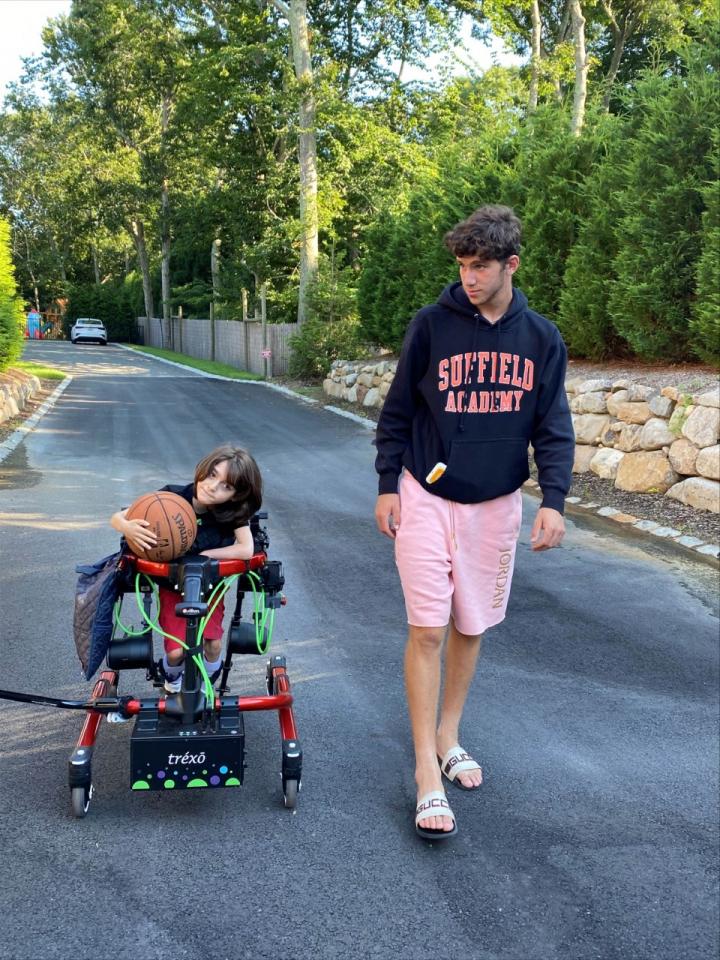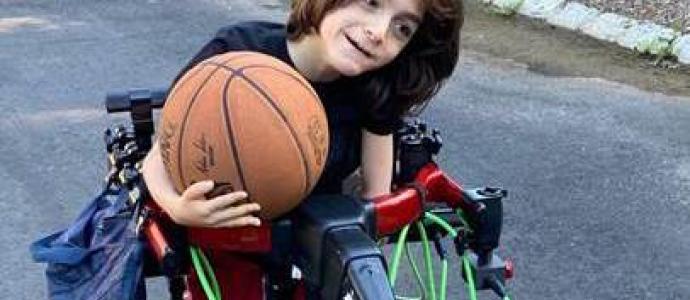Share
 For students at the International Academy of Hope (iHOPE), YAI’s school for children with brain injuries, working to increase their independence is an essential part of the curriculum. When iHOPE staff saw one of their students taking steps with the help of a cutting-edge mobility device, they wondered how many of the other students could also benefit from it.
For students at the International Academy of Hope (iHOPE), YAI’s school for children with brain injuries, working to increase their independence is an essential part of the curriculum. When iHOPE staff saw one of their students taking steps with the help of a cutting-edge mobility device, they wondered how many of the other students could also benefit from it.
Like many children with brain disorders and injuries, 9-year-old Jackson had little freedom of movement before he started using the gait trainer made by Trexo Robotics. Now, more than a year after his family bought him the Trexo, Jackson takes up to 1,000 steps a day using the exercise trainer and is able to actively move his legs forward with less assistance when not using the device.
iHOPE physical therapist Bella De Guzman, who has been working with Jackson since mid-2019, wasn’t familiar with the Trexo until he brought it to school. She was impressed by how it effectively simulates actual walking and teaches Jackson how to move his legs.
“It’s really helping him,” she says. “It’s training his brain on what he needs to do to move and then is giving feedback to his muscles, boosting his brain’s neuroplasticity.”
The Trexo encourages children to improve their gait and endurance with the help of motorized robotic legs operated by a computerized tablet. Depending on the child’s tolerance, the tablet sets the speed – how many steps per minute – and customizes settings for knee and hip extension. It also tracks a child’s history of steps taken and rates of initiation.
De Guzman was so excited about Jackson’s progress after he returned to school in September following the coronavirus quarantine that she shared before and after videos documenting his improvement with Trexo Robotics, which posted them on their Instagram page.
In the earlier video, the therapist is giving Jackson maximum support by walking behind him with her arms around his torso and her feet pushing his heels forward. In the newer video, she sits on a rolling chair behind Jackson with her arms around his pelvis as he moves his legs forward on his own.
De Guzman and her colleagues soon realized that obtaining a Trexo for iHOPE could benefit many of the East Harlem school’s 76 other students who are non-ambulatory.
Unfortunately, the robotic trainer’s nearly $35,000 price tag was too expensive for the school, one of few in New York that specializes in supporting young people ages 5 years to 21 with sustained acquired brain injuries or other brain-based disorders who cannot be served by their local school systems.
While considering ways to raise the money, YAI staff members learned that Trexo Robotics had launched a contest to give the technological device to the two top-scoring schools or health care facilities. iHOPE’s Associate Program Director Mayra Diaz-Garcia and Senior Speech Therapist Jaclyn Litvack launched a vigorous campaign to get as many votes as possible and succeeded in three weeks to win one of the coveted Trexos.
iHOPE will get the trainer in February and be able to keep it for a year. Afterward, the school will be able to purchase the Trexo at a discount or lease it month-to-month.
“It’s a great way to try it ourselves and to figure out which population will benefit from it the most before we consider allocating such a large amount of money,” says Diaz-Garcia.
She acknowledged that iHOPE needs more evidence about how often students need to use the Trexo to gain strength and mobility, but says she can’t deny its positive impact on Jackson.
“When he is in the Trexo, he is so happy and is more social,” Diaz-Garcia says. “It’s the best time to get him to communicate and show his emotions.”
Jackson’s mother, Jackie Harris, says it has made a huge difference in her son’s life both physically and mentally.
“Seeing how happy he was to be upright and moving was a view into freedom for him,” she says. “It’s building his muscles and his awareness of the world by being upright.”
Harris says iHOPE has been very supportive of Jackson’s use of the Trexo, with staff and students cheering him on.
The creation of the Trexo grew out of the personal experience of company founder Manmeet Maggu, who was determined to find a mobility solution for his nephew when he was diagnosed with cerebral palsy. With the help of a friend trained in robotics, he created the Trexo for children.
Harris says her son uses his Trexo nearly every day.
“He loves it and gets very excited about it,” she says.

